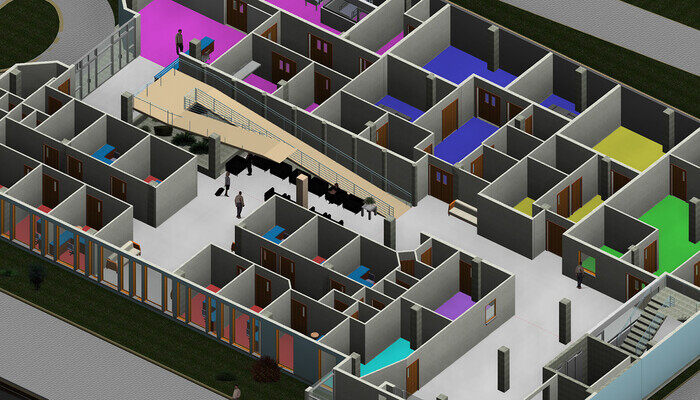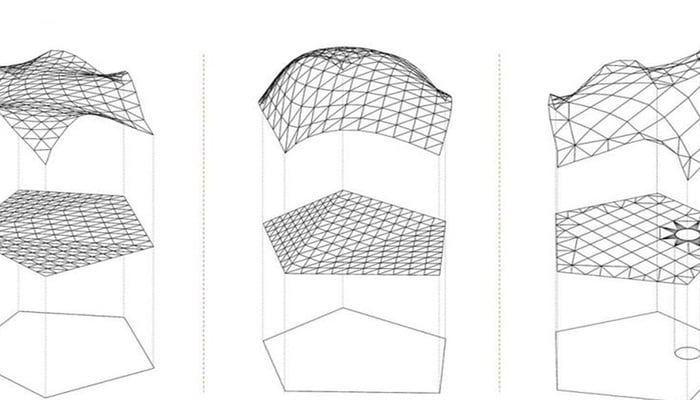5 Diploma/Certificate Courses In Computational Design (2024)

Table of Contents
The Architectural, Engineering, and Construction Industry (AEC) is witnessing a wave of technology-driven solutions. As the challenges in the industry grow, many new technologies and solutions have been introduced to keep up with the evolving requirements. One such solution is Computational Design, which uses technologies like BIM (Building Information Modelling) to help architects and designers reduce their workload. It enables them to create complex designs with ease and within time constraints. This blog will discuss what Computational Designers do, the various online Computational Design courses and degrees available, and how they can help uplift your career.
What is Computational Design?
Computational Design is a multidisciplinary approach to building architectural designs that combine mathematics, computer science, and design principles to create innovative solutions and experiences. You can use algorithms, data-driven methods, and computational tools to generate and optimise complex designs. This approach goes beyond the limitations of human intuitions and manual processes, opening up new possibilities for innovation and problem-solving in various fields, such as architecture, engineering, and product design.
Most Computational Design tools rely on visual programming as opposed to text-based programming. As a result, you get the power of programming without the need to learn coding. Notably, visual programming enables you to assemble programmes graphically instead of writing code. You can also watch our video to learn more about Computational Design.
What do Computational Designers Do?
Computational Designers leverage the power of computers to explore design spaces, optimise different parameters, and achieve exceptional outcomes that would not be possible through traditional methods alone. Computational designers can work across various fields, from architectural and industrial design to graphic design and fashion design. They essentially focus on leveraging computational techniques, and therefore, there are no boundaries for creativity and problem-solving techniques.
You can leverage Computational Design tools to create complex and responsive structures that adapt to various factors like environmental conditions, energy efficiency, and aesthetic preferences. For instance, you can create building facades that adjust to the angle of the sun for optimal light and shading. Given these skills, a huge demand exists for architects and designers proficient in Computational Design. Therefore, it only makes sense to enrol yourself in Computational Design online courses and stay competitive in the industry.
Benefits of Computational Design Courses

Computational Design Master’s degree and diploma courses offer a wide range of benefits that make them valuable for architects looking to enhance their skills in this dynamic field. Let’s look at some key benefits of Computational Design Degree and certificate courses:
- Access to Industry Experts: Computational Design online training courses are taught by industry experts and experienced practitioners from around the world. This helps you get access to real-world experience from industry veterans themselves. Besides, direct exposure to seasoned professionals enhances the quality of education.
- Diverse Learning Resources: Most Computational Design architecture online courses incorporate various teaching techniques—live classes, recorded video lectures, interactive simulations, and discussion forums. This diversity makes the classes exciting and lively, enhancing the learning experience. These courses also include practical assignments and projects to let you apply the concepts that you’ve learned in real-world scenarios.
- Global Accessibility: Online Computational Design Architecture courses break down geographical barriers, giving you access to high-quality learning regardless of location.
Flexibility & Convenience: Online Computational Design certificate/degree course provides the flexibility to learn from anywhere and at your pace. This is particularly advantageous if you are a working professional and need to study at your convenience. Besides, you also get the freedom to go through the reading material at your own pace, spend more time on challenging topics or move quickly through the familiar ones.
Types of Specialisations in Computational Design
Computational Design is not about learning textual coding. It involves tools that function in visual programming and help architects develop their designs graphically. Learning it can provide you with a competitive edge in the market as it prepares you for real-world scenarios and equips you with the skills that are highly sought-after in the AEC industry.
Doesn’t Computational Design sound interesting to you now? What if we tell you that there are multiple specialisations in the field as well that you can pursue as per your interests? As we have already discussed what a Computational Design course is, let us now talk about the various specialisations in Computational Design:
1. Parametric Design

Parametric Design is a branch of Computational Design that is based on algorithm thinking—it develops parameters to determine building design. With the help of Parametric Design, you can conveniently iterate designs, including complex geometries, while using a set of parameters like length and breadth. For instance, if you change any individual parameter in the above image, the whole design will be refreshed or updated with the help of a Parametric Design tool. This can reduce manual labour and save a lot of time.
2. Algorithmic Design

When you enrol yourself in a Computational Design Degree Course, you can choose to specialise in Algorithmic Design as well. Unlike Parametric Design, which uses parameters, Algorithmic Design uses algorithms to generate ideas and designs. Simply put, an algorithm is a set of instructions you must follow to solve a particular problem. In Algorithmic Design, you must follow a defined and logical set of rules to generate your desired design. The algorithms here describe information and a logical sequence to generate a design.
Notably, another difference between Parametric Design and Algorithmic Design is that in Parametric Design, you can manipulate the existing conditions, while in Algorithmic Design, you need to follow set rules and instructions
3. Generative Design

In Generative Design, you can interact with technology to create designs and drive innovations quickly. You can also specify your requirements, such as preferred materials and manufacturing processes, with the Generative Design software. The software will automatically produce various designs you can evaluate to achieve your desired results. As a result, you can create superior designs while saving your efforts and time.
4. Biomimetic Design

The word biomimetic is a combination of two Greek words - bios and mimesis, which mean life and imitate, respectively. Thus, Biomimetic Design is a scientific approach to building sustainable designs with the help of design principles found in nature. You can simply say that a Biomimetic Design takes inspiration from nature and replicates the biological organisms’ behaviour. It replicates processes and strategies found in nature to solve design problems sustainably.
5 Most Demanding Diploma/Certificate Courses in Computational Design
The advent of Computational Design in the AEC industry has had a massive impact on all architects and professionals. From drawing with HB pencils and rulers to using a range of software to design, the field has undergone a huge revolution. Today, there is a high demand for Computational Designers in the market. Take a look at the top five online Computational Design Courses where you can enrol yourself for upskilling and gain a competitive edge:
1. Novatr - Master Computational Design

Type of Course Offered: Certificate
Duration: Six months
Novatr offers an online Computational Design Course for architects and civil engineers at one-tenth of the price of a typical master’s programme. This six-month Computational Design course lets you master advanced design technology. The curriculum for the course is designed by industry experts, ensuring that your learning journey is filled with industry-relevant topics that focus majorly on real-world applications. In this course, you will learn basic modelling techniques in Rhino 3D, visual programming techniques in Grasshopper, along with complex data structuring.
Here’s what you’ll learn in detail:
- Learn 5 powerful industry tools — Grasshopper, Rhino 3D, Flux.ai, ComfyUI, and D5 Render.
- Master popular plugins like Paneling Tools, DeCoding Spaces, Anemone, Galapagos, Wallacei, LunchBox, Open nest and Horster Animation to create smarter, faster design workflows.
- Understand how to build parametric and generative design workflows used by top global firms.
- Learn how to automate repetitive design tasks, explore AI-driven creativity, and produce high-quality renders for presentations.
- Develop a professional computational design portfolio showcasing your project-based learning.
Earn dual certification from Novatr and NSDC (National Skill Development Corporation) upon completion, and step confidently into the world of future-ready architecture and design.
Disclaimer - Course details, including curriculum, duration, fees, and related information, are for informational purposes only and may change at the company’s discretion without prior notice. Please visit the official course page or contact our admissions team for the latest updates.
2. UCL Bartlett - MSc. in Architecture Computation

Type of Course Offered: Diploma
Duration: One year
A globally renowned architectural school, the Bartlett School of Architecture offers a Master's degree in Architectural Computation that equips you with skills to create responsive and generative designs. The programme consists of five modules - Computational Analysis, Computational Synthesis, Design as a Knowledge-Based Process, Introduction to Programming for Architecture and Design, and Morphogenetic Programming, and a dissertation - Built Environment Dissertation. You get a Master’s Degree in Computation Design upon completing 180 credits in a year. Alternatively, you can get a PG Diploma in Computational Design with 120 credits.
3. DesignMorphine - Master of Science Project

Type of Course Offered: Degree
Duration: Nine months
An online educational institution, DesignMorphine offers a 9-month Master of Science programme in Computational Design, accredited by the University of Architecture, Civil Engineering, and Geodesy (UACEG). The Computational Design course is accessible from all around the world and aims to help architects and engineers who wish to excel in the multidisciplinary field of Computational Design. The curriculum is divided into five technical and theoretical labs that create a unique and collaborative learning experience.
4. IAAC - Master in Advanced Computation for Architecture & Design
%2c%20Barcelona%2c%20Spain.jpg?width=700&height=400&name=Institute%20of%20Advanced%20Architecture%20of%20Catalonia%20(IAAC)%2c%20Barcelona%2c%20Spain.jpg)
Type of Course Offered: Degree
Duration: Ten months
The Institute of Advanced Architecture of Catalonia (IAAC) offers an online Computational Design Master’s Degree course in synchronous or asynchronous formats. Its curriculum includes an interesting mix of theoretical and practical knowledge through the application of analysis, design simulation, and digital data optimisation. During the course tenure, you will study three modules on advanced computation for environmental and structural design, BIM (Building Information Modeling) and smart construction, and Artificial Intelligence in architecture.
5. Columbia - Master of Science in Computational Design Practices

Type of Course Offered: Degree
Duration: Three semesters (summer, fall, spring)
The Master of Science in Computational Design is a newly launched course offered by Columbia GSAPP that integrates disciplines between architecture, data visualisation, and urban planning—focusing majorly on Computational Design practices. The Computational Design course consists of colloquium courses, one each semester, and prepares you for various roles in architecture, civil design, and planning.
Conclusion
Playing a pivotal role in shaping the future, Computational Design is bound to revolutionise the Architecture, Engineering, and Construction (AEC) industry. It is a powerful tool that reshapes how buildings are designed, constructed, and experienced. With subsets like Parametric Modelling, Generative Design, and Digital Fabrication, Computational Design enables you to create more efficient, innovative, and sustainable built environments. Thus, learning advanced design skills like Computational Design has become a necessity today.
If you are thinking about becoming a Computational Designer, then it’s time for you to enrol yourself in Novatr’s Computational Design course designed for architects and engineers. Unlock your creativity, build your portfolio, and showcase your knowledge and skills to your potential employers with the Computational Design course offered by Novatr.

 Thanks for connecting!
Thanks for connecting!


.png)


.jpg)




